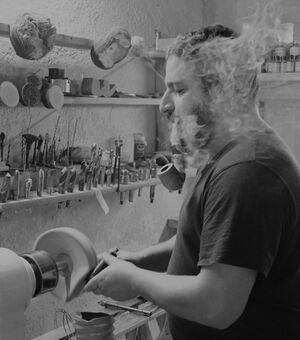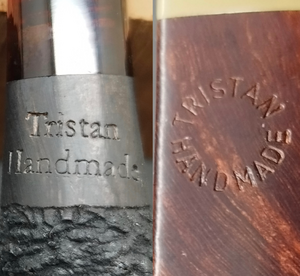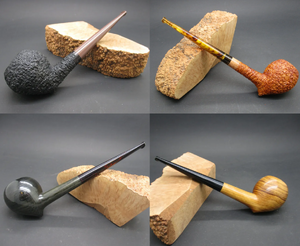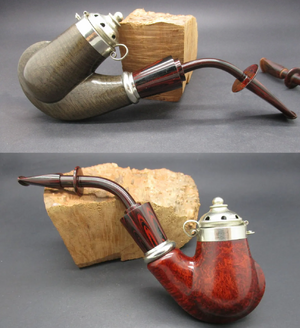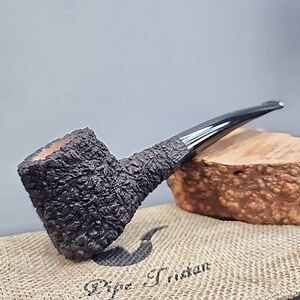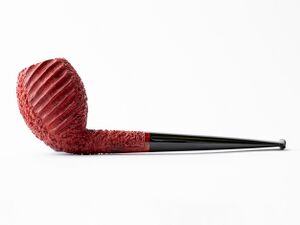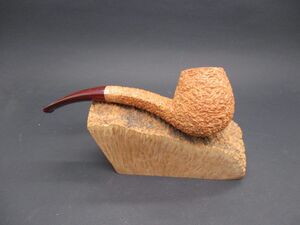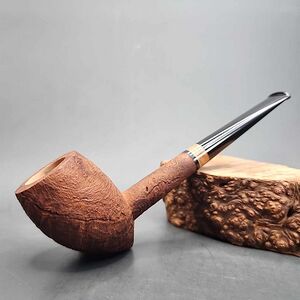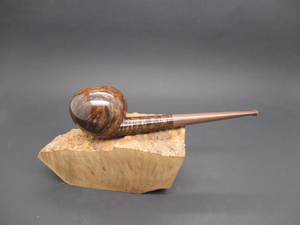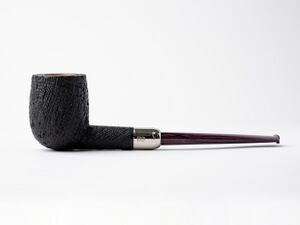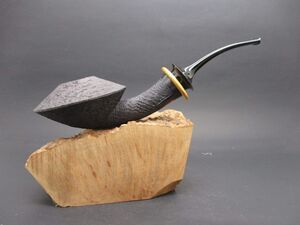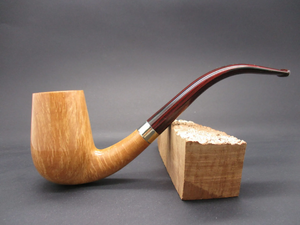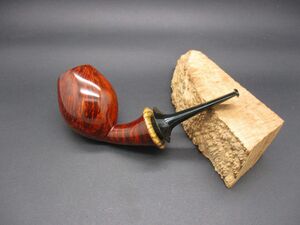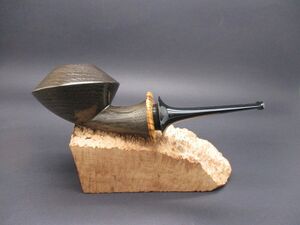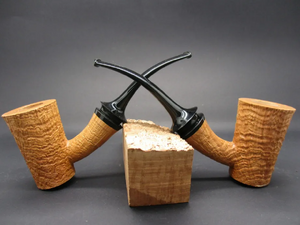Pipe Tristan
Pipe Tristan is a brand of hand-made pipes created by the French artisan Tristan Lefebvre (b. 1986).
Lefebvre lives in the south-east of France with his wife and daughter. A pipe-smoker since the age of 16, Lefebvre has had a lifelong love affair with pipes, though his most passionate interest has been in group of pipes rarely considered by many smokers and enthusiasts. As a collector, Lefebvre's choice of pipes include those originating in what is now Germany several hundred years ago, such as the Tyrolean, or Bavarian, clay hunter's pipes; and the lesser-known Hungarian, or Ulmer Maserholzpfeifen,[1] 17th century tobacco pipes originally made from the roots of trees such as elm or birch. While these pipes have not been Lefebvre's primary focus when making those of Pipe Tristan, he has produced his own renditions of them occasionally, examples of which can be seen below.
In 2016, Lefebvre began to make his own pipes. Through these pipes, Lefebvre explored a variety of styles and a variety of materials, including briar, bog oak (morta), and olive wood. When looking back through the Pipe Tristan archives on Lefebvre's website (see below), one finds a diverse mixture, from Dunhill-style 'LC'/swan-neck bent billiards, to Danish-American Rhodesians, to French fleurs, and to simple, classic Dublins. Already having a background in woodworking, Lefebvre is self-taught, using online guides and articles from pipe-makers in order to refine the technical aspects of his craft.
In 2020, Lefebvre took a two year hiatus from pipe-making. The pipes made after his return in 2022 show a more concentrated design approach. Along with a greater preference for briar or arbutus wood, this included the emergence of two signature finishes for Pipe Tristan, as well as one signature shape. While the average Tristan between 2016-20 was smooth polished (whether briar, bog oak, or olive wood), Lefebvre now produces many pipes in his 'Granite' and 'Ammonite' rustication styles. The Granite finish is recognizably Italian in inspiration, being a granular, stony rustication with similarities to Castello (one of Lefebvre's favorite contemporary makes), Paolo Becker, or Radice. Granite Tristan pipes are, however often sharper and more 'raw' in execution than their Italian cousins. Lefebvre's Ammonite finish combines an even finer, gritty base rustication with channels then carved into the bowl. Those familiar with common marine fossils may recognize the namesake of this finish, as well as the connection between the carvings applied to Ammonite Tristan pipes and the shells of pehistoric Ammonoids, such as Asteroceras stellare or Perisphinctes choffati.
The other recurrent motif in Lefebvre's more recent work is the 'Chestnut' shape, which by his own account was inspired by the chestnut trees in his home region. While there are similarities to the popular Scandinavian-style acorn- and strawberry-shaped bowls found, for example, in the designs of Sixten Ivarsson, Nanna Ivarsson, and many other Scandinavian and Scandinavian-inspired pipe-makers, Lefebvre's Chestnuts are more minimalist in form. Instead of sharp or sweeping curves, Lefebvre typically situates the bulbous bowl of the Chestnut, along with its tapering heel, at the end of a straight, pencil shank, in a manner not unlike a more organically inclined traditional cutty. While the proportions of the Chestnut's bowl tend to be rounder and fuller than the cutty, with a larger bowl relative to the shank and stem, the overall aesthetic of Lefebvre's design is more restrained than the avant-garde stylings of much of the Scandinavian tradition, especially in its later stages. It is, however, unmistakably distinct from anything in the classical English-French shape catalog.
On the other hand, Lefebvre does pay homage to certain modern staples in his contemporary output. Castello's 'shape 55' is clearly a personal favorite, with Lefebvre returning to this shape in particular repeatedly in the last few years. While some Pipe Tristan 55s stay close to Castello's standard, some accentuate its features, such as the shape's signature arching heel, producing something that is perhaps closer to Radice's interpretation, while remaining distinct from either of the Italian makes. While not a shape original to Castello, Lefebvre's approach to the 'hawkbill' shows a similar nod to Carlo Scotti's iconic 'shape 84' rendition, especially when paired with Lefebvre's Granite rustication and a fumed stain reminiscent of Castello's Old Sea Rock line (other Italian precedents include Brebbia's Dune Buggy line, as well as certain Caminetto Business pipes).
A feature of Tristan pipes not common to Italian pipes is Lefebvre's use of color. Lefebvre is one of a number of artisans who, in recent years, have employed unorthodox color combinations in their work, breaking away from the brown-black and blonde-black preferences common to the Danish and Italian artisan scenes. Like Rich Rosselli's Smith House Pipes, Xin Li, or Michele Brentegani, Tristan pipes also tend to opt for color schemes that are warmer and more playful than many of their contemporaries, while at the same time remaining subtle and avoiding flamboyance. In the case of Pipe Tristan, this is often achieved by pairing a simple, monotone SEM resin or amberoid acrylic stem with near-naked briar or an onyx-black stain, but there are many other, similarly tasteful, combinations and compositions to be found in Lefebvre's catalog.
To date, Tristan pipes have been sold at MBSD Pipes and The Country Squire.
Contact Information
Website: https://www.pipe-tristan.com/en/ Email: pipetristan@yahoo.com Instagram: https://instagram.com/pipe.tristan
